
Temple of Tlahuizcalpantecuhtli, Tula, MEXICO
| Translate: Español - Français - Deutsch - Italiano - Português - Japanese - Korean - Chinese |

Temple of Tlahuizcalpantecuhtli, Tula, MEXICO
| Translate: Español - Français - Deutsch - Italiano - Português - Japanese - Korean - Chinese |

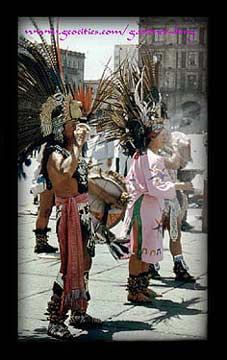
April 3, 1999 -- We take a bus and head east for an hour to Mexico City (80km) is similar in altitude to that of Toluca, but the pollution levels make the whole valley more of a health hazard.
Is there ever a logical reason as to why some of the world's largest cities are built in the most impractical of settings? Mexico City, being 7,400 ft a.s.l., is ringed by mountains and volcanoes, set on a fault line, far from water, food and energy supplies and, literally, short of oxygen.
Around 20,000 years ago, nomadic tribes arrived into this region, but it was not until around 200 BC that Teotihuacan City was to become central to Mexican political culture. Over the next thousand years, there was increased migration to the area and by the time the Aztecs founded Tenochtitlan on an island in Lake Texcoco in 1325, the Valley of Mexico was well settled with towns and villages. At the height of the Aztec empire,, Tenochtitlan was recognised for its military, political, religious and commercial might. This fact alone convinced the Spanish, after the Conquest of 1521, to build Mexico City on the same site.
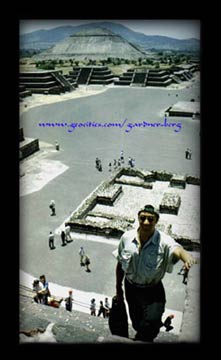
April 4, 1999 -- We visit Mexico City's Zocalo - centre of the oldest part of the city. Here is where we view the oldest and largest Cathedral in Latin America. Inside, there is major restoration taking place. When it was built in 1573, no-one realized that the foundations would not be solid enough for the immense weight of the project. Now, the Cathedral is slowly sinking in various areas. When we walked around inside we passed massive scaffolding holding up a large portion of the weight.
A solution to this problem has yet to be found.
Interestingly, next to the Cathedral is another structure built in 1769. Unlike the Cathedral, the 'Sagrario Metropolitano' was built on the remains of an Aztec pyramid and thus more stable. Just around the corner NE of the Cathedral are the excavated ruins of Templo Mayor.
'Templo Mayor' or 'The Great Temple' of Tenochtitlan was dedicated to Huitzilopochtli and Tlaloc - the gods of war and water. These Aztec ruins were accidently discovered in 1978
during the construction of a subway line. It is known, presently, that for the Aztecs, a new temple was built on top of the old one every 52 years. At this particular site, 7 have been identified on top of each other.
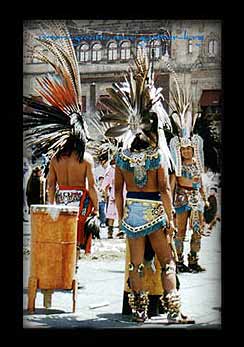
April 6 -- An hour's bus ride north of Mexico City - we arrive at the archeological site of Teotihuacan. Said to have been built at around 300 BC, very little is known of its builders. At the height of its power, the city's inhabitants probably numbered around 200,000 to 250,000 making it possibly the world's most populous at the time. Today, the remains of its huge Pyramids of the Sun and Moon and its 2 mile long 'Avenue of the Dead' testify to its vastness. The 'Pyramid Of The Sun', for example, has a cubic area almost the same as that of the 'Great Pyramid of Cheops' in Egypt. (64m high and 213sq.m at the base)
It was a very hot day today but very much a highlight so far. Fortunately, we got to the site early. Around 10am, the whole area became swamped with tourist groups. Certainly something we have to keep in mind when visiting other ruin sites.
April 7, 1999 -- 'Plaza Santiago de Tlatelolco' - also known as 'Plaza de las Tres Culturas'(Plaza of 3 Culturas) i.e. Aztec, Colonial and Modern - to venerate Mexico's mixed blood heritage. There is a Franciscan Church (1609), an Aztec ruin site and a Foreign Ministry Building. A nice garden setting.
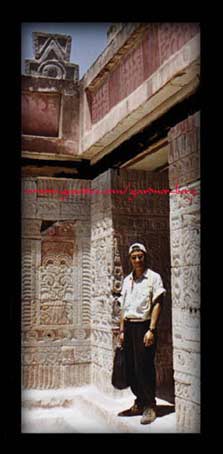
There is a plaque, placed in front of the church, that reads:
"On August 13, 1521, heroically defended by Cuauhtemoc, Tlatelolco fell into the hands of Hernan Cortes. It was neither a triumph nor a defeat: it was the painful birth of the mestizo nation that is Mexico today."
On October 2, 1968, at around 5.30pm, a large number of student-protesters were killed by the Army under the presidency of Gustavo Diaz Ordaz. Journalists were banned from entering the site after the shootings, which was enough time for the Army and Fire services to clean up the mess that night.
As the host nation of the 1968 Olympic Games, Mexico was able to control the television images being fed to the world, hiding the severe state of civil unrest.
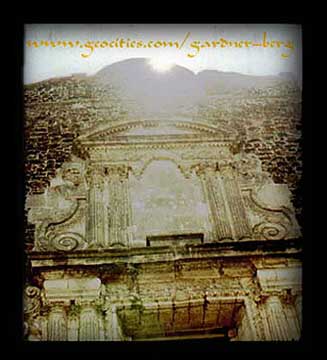
April 8, 1999 -- The ruins of Tula: 1 and a half hours almost directly north of the city by bus. Tula is thought to be the major centre of the Toltec culture. The emergence of the Toltecs can be traced directly to Teotihuacan - the preceding culture to Tenochtitlan, of which human sacrifice was of paramount importance among the priests upholding the city's religious rites.
There is the legend of Quetzalcoatl (The Plumed Serpent), already recorded in stone in Teotihuacan and recognised by this society as the inventor of medicine, agriculture, astronomy and royalty; assumed greater importance and even a physical identity under the Toltecs. Quetzalcoatl's father, was murderd
by his brother, Ihitmal leading to his succession to power. The young
Quetzalcoatl was saved and brought up by priests. He thenmurdered his uncle, Ihitmal and became leader of the Toltecs at the city of Tula. During his reign, he had human sacrifice banned and stimulated artistic creativity,
placing the priest on the wayside. So, they conspired to deceive him into breaking his vows of chastity thus forcing him to abandon his throne. He fled to Cholula and, it is said, he took to sea in a boat 20 years later with the promise of returning. He supposedly landed in the Yucatan where he died 30 years later, on a self-made funeral pyre.

Toltec influence can be seen in the major structures of Chichen Itza in the Yucatan Peninsula. The top of El Castillo (the large pyramid), for example, is decorated by the symbol of Quetzalcoatl and at the base of each balustrade of 91 stairs up each of the 4 sides, there's a decorated head of a plumed serpent.
The ruins of Tula has remains of 2 ball-courts, pyramids, a frieze panel still retaining some of its original colour and magnificent 6m high sculptures made of black basalt - the Atlantes anthropomorphic pillars. These pillars now sit on the top platform of pyramid B on site. A very unique archeological find.
April 9, 1999 -- A ride on the Metro to Tasqueña Station, and then a 20 minute ride on a rail tram to Embarcadero and finally a short walk south we arrive at Xochimilco Floating Gardens. Xochimilco is famous for its canals (built long before the arrival of the Aztecs) and colourful boats called trajineras. We hired one of these boats and for a couple of hours relaxed in the sunshine, passing other boats of specific purposes; floating mariachis, food and drink services, photographers, florists. Many families picnic here to escape the city's bustle.
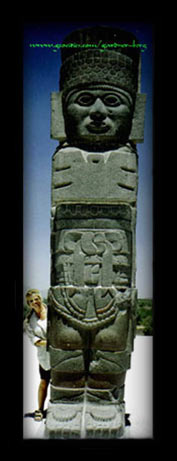
April 10, 1999 -- A brownish smog covers the Valley of Mexico most days of the year - most evident on our arrival here. Because Mexico City is surrounded by mountains, thermal inversion frequently traps pollution within the urban bowl. The region's sunshine and thin air, in turn, generate a kind of photochemical smog. Burning eyes and a sore throat is what we generally felt during our stay.
An interesting observation in the city are the many young foreign travellers smoking cigarettes amidst this kind of environment. At a time where environmental awareness, growing vegetarianism and a need for better health are becoming entrenched in the travel culture, it certainly goes against, perhaps, common sense. What one hears and what one sees are two different things. Each day, thousands of tons of metals, chemicals, bacteria and dust are poured into the atmosphere, darkening the sky before returning to earth. And, in the early months of each year, dust storms head into the city from the east and northeast, partly as a result of deforestation of close to 80% of the valley but, more seriously, these storms also blow in from the dried-up bed of Lake Texcoco. Decades earlier, to prevent flooding and to allow the city to expand, it was deemed necessary to drain the lake.
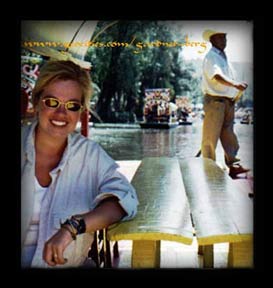 Now, the valley's entire ecological balance is disturbed. Some of the city's sewage systems flow into the area and improvised open-air toilets are common; so the dust contains dried excrement and bacteria. The lake-bed is dry during the winter and muddy during the summer rainy season. It's unsuitable for urban development (although many slums now stretch into it), while its highly saline soil prevents its surface from being farmed or reforested.
Now, the valley's entire ecological balance is disturbed. Some of the city's sewage systems flow into the area and improvised open-air toilets are common; so the dust contains dried excrement and bacteria. The lake-bed is dry during the winter and muddy during the summer rainy season. It's unsuitable for urban development (although many slums now stretch into it), while its highly saline soil prevents its surface from being farmed or reforested.
It's a very complicated problem to solve; a problem, we feel, that is most likely irreversible.
April 11, 1999 -- Probably one of the best museums in the world: Museo Nacional de Antropologia. To see everything, you need 2 days. A great collection of artifacts divided into 23 separate halls in chronological order, all of which are displayed in aesthetic surroundings. Central to this vast collection is a 350m facade and an immense patio shaded by a gigantic concrete mushroom, 4,200 sq.m - the world's largest concrete and steel expanse supported by a single pillar.
Photos and Text Copyright © 1999-2001 Gardner-Berg. All rights reserved.
Sources of Further Reading-
Baldwin, Neil. Legends of the Plumed Serpent: Biography of a Mexican God.
Conrad, Geoffrey E. Religion and Empire: The Dynamics of Axtec and Inca Expansionalism. 1984
Leon-Portilla, Miguel. Aztec Thought and Culture: A Study of the Ancient Nahuatl Mind. 1990
Leon-Portilla, Miguel. Klor De Alva, Jorge J. The Broken Spears: The Aztec Account of the Conquest of Mexico. 1992
McManus, Kay. Lord of the Five Suns - Looking at Aztec Myths and Legends. 1997
Taube, Karl. Aztec and Maya Myths. 1994

